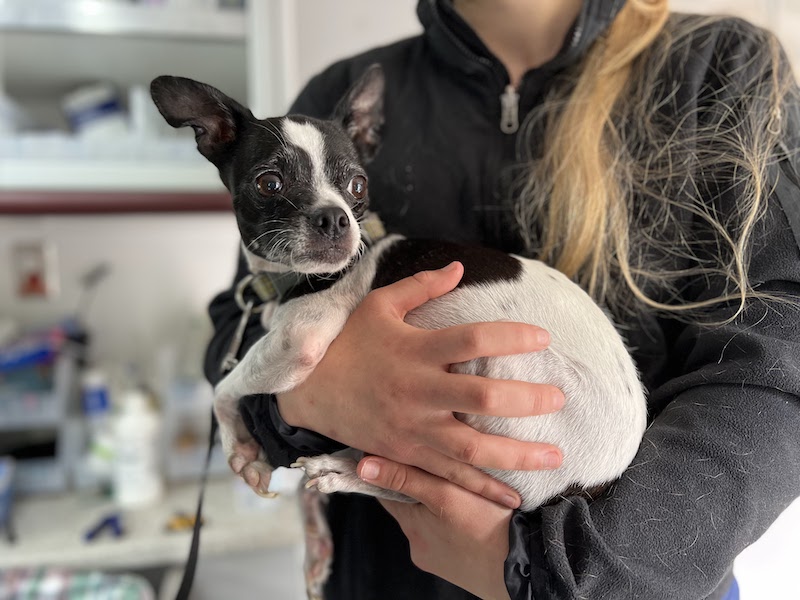Mission Statement
Our mission is to address the epidemic of violence and preventable suffering in at-risk animals and people.
In honor of our most vulnerable community members, we envision a world where suffering is prevented and trauma is healed through fierce compassionate action and human animal connection.

Ruthless Kindness was founded by two veterinarians who have worked extensively in underserved communities and animal shelters. Through their work, they soon realized that medical treatment for individuals, while extremely necessary, is not enough. What was needed was a way to address the fact that suffering animals are linked to suffering people, forgotten animals are linked to forgotten people and at-risk animals are connected to at-risk people.
And they challenged themselves to better support people and their pets by getting in front of the abuse, neglect and suffering they were seeing on a daily basis.
Ruthless Kindness partners with human service providers and victim advocates to provide urgent and immediate support to people and their pets so that in moments of crisis the human animal bond can be preserved. Maintaining the human animal bond will prevent unnecessary suffering and will heal the trauma of both people and animals. Pets are family.
As veterinarians, we approach our work through science-backed prevention, immediate treatment and long-term solutions. We provide urgent veterinary care, facilitate emergency housing, partner on case management and proactively communicate about the need to include pets in all plans to support victims of crime and at-risk community members. Using empathy as a long-term antidote to abuse is key to our process.
Is there data regarding the overlapping needs of animals and people?
- There are approximately 70 million pet dogs and 74 million pet cats in the US (AVMA). 67% percent of US households, or about 85 million families, have a pet, according to the 2019-2020 National PetOwners Survey (APPA).
- Nearly 40 million Americans, roughly 12 percent of the country, are living in poverty. That total is more than the number of people living in Canada. Over 23 million cats and dogs are living in underserved communities (Bershadker). Percentage of pets living in underserved communities who are not spayed or neutered: 87%. Percentage of pets living in underserved communities who have never seen a veterinarian: 77% (HSUS).
- A 2015 ASPCA study of pet owners who reported giving up a pet within the last five years showed that 40% of those with annual incomes below $50,000 indicated that free or low-cost vet care would have prevented them from relinquishing their pets, and 30% said free or low-cost pet food would have helped them the most.
- For families with pets, human food, shelter and medical challenges are transferred from owners to their animals, sometimes requiring painful decisions that put both the pets and family units in jeopardy. But while poverty may increase the risk of pet surrender, there is no data to support the notion that impoverished owners do not love their pets or are less committed to providing responsible care than owners who are financially secure (CDC).
- A study of women seeking shelter at a safe house showed that 71% of those having pets affirmed that their partner had hurt or killed their companion animals (Ascione).
- A study of pet-owning families with substantiated child abuse and neglect found that animals were abused in 88% of homes where child physical abuse was present (DeViney, Dickert, & Lockwood).
- Domestic violence, child abuse, and animal abuse frequently occur simultaneously in a family (AWI).
- Between 18% and 48% of women with pets delay leaving a dangerous environment for fear of their pets’ safety (AWI).
- Based on NVAWS (National Violence against Women Survey) data, an estimated 5.3 million domestic violence victimizations occur among U.S. women ages 18 and older each year. This violence results in nearly 2.0 million injuries, more than 550,000 of which require medical attention (CDC). Different reports state that around 1 million animals are abused each year in association with domestic violence. The animals whose abuse is most often reported are dogs, cats, horses and livestock (HSUS).
- A study showed that violent offenders incarcerated in a maximum security prison were significantly more likely than nonviolent offenders to have committed childhood acts of cruelty toward pets (Merz-Perez, Heide, & Silverman).
- In polling, 94% of Americans agree that animals raised for food deserve to live free from abuse and cruelty. Yet the majority of the nearly 10 billion land-based animals, plus countless more aquatic animals, farmed for food each year in the U.S. live in illegal and inhumane conditions that do not align with consumers’ values (ASPCA). Over 1 million children in the US are directly involved with food animal organizations, and if exposed to cruelty or ethical disconnects, may struggle with empathy.
- High-school killers such as Nikolas Cruz in Parkland, Florida and Luke Woodham, in Pearl, Mississippi, tortured animals before starting their shooting sprees (Washington Post). Columbine High School students Eric Harris and Dylan Klebold, who shot and killed 12 classmates before turning their guns on themselves, spoke to their classmates about mutilating animals (Boston Globe).
- Because abusers are often targeting the “powerless”, crimes against animals, children, spouses, and the elderly often go hand in hand. This is why animal abuse is called a “gateway crime” (US Dept. of Justice, 2018).
- A 2001-2004 study by the Chicago Police Department "revealed a startling propensity for offenders charged with crimes against animals to commit other violent offenses toward human victims." Of those arrested for animal crimes, 65% had been arrested for battery against another person.
- Pet abuse is one of four predictors of domestic partner violence, according to a six-year "gold standard" study conducted in 11 metropolitan cities. In both domestic violence and child abuse situations, abusers may manipulate and control their human victims through threatened or actual violence against family pets.
- Experts are just starting to understand the special relationship between children and animals, which appears to have profound benefits for both animals and children. Evidence shows that spending time with animals can increase a child’s self-esteem, help children develop socially and promote children’s cognitive development. (Froma Walsh, PhD, University of Chicago)
- According to the American Academy of Child and Adolescent Psychiatry, the advantages of having an animal in a child’s life include developing responsible behavior, providing a connection with nature, teaching children respect for other living creatures, providing lessons about life, and on the emotional level through the experience of physical contact, tactile touching, allowing a child to gain security in oneself and in relationships. Interacting with an animal that does not speak allows the child to assimilate rules of non-verbal communication, which is beneficial for developing the capacity for intuition.
Above is only a partial list of facts demonstrating that what creates the greatest risk for insufficient care and abuse is dependence on someone else. The research is clear: Both domesticated animals and children are reliant on us for shelter, food, medical care, and affection, and therefore are susceptible to neglect, abuse, and other forms of innocent suffering.
